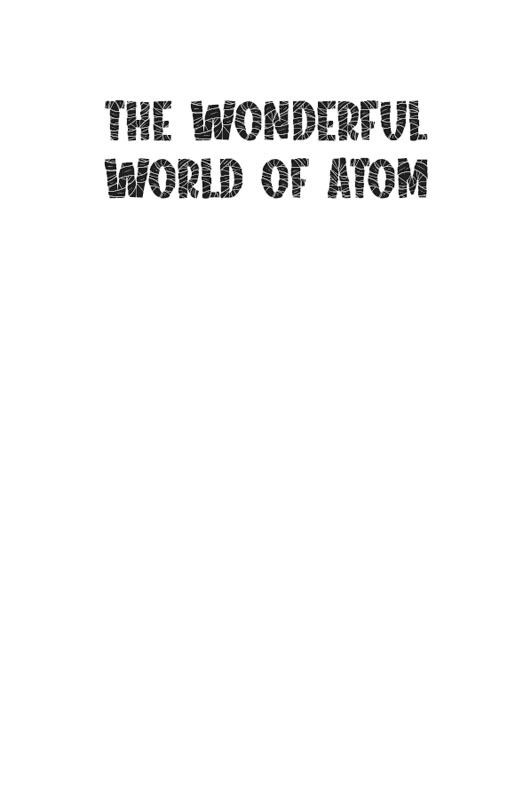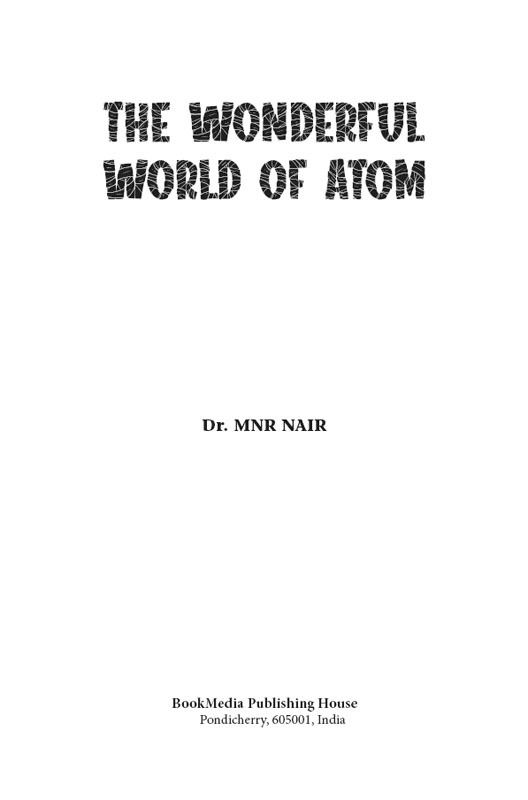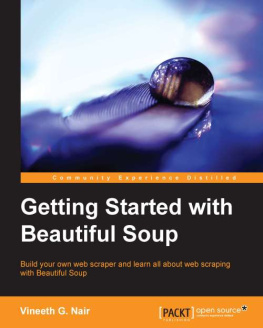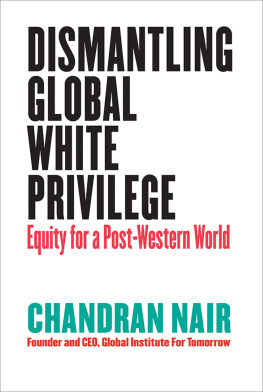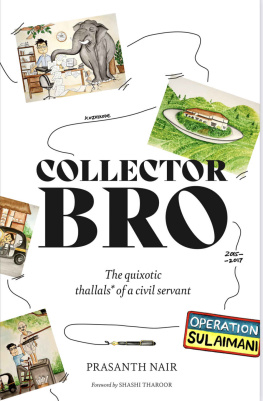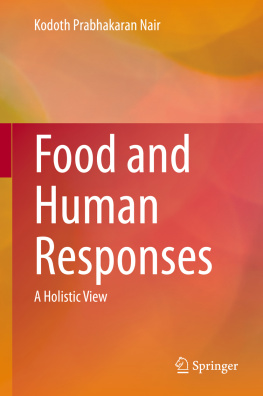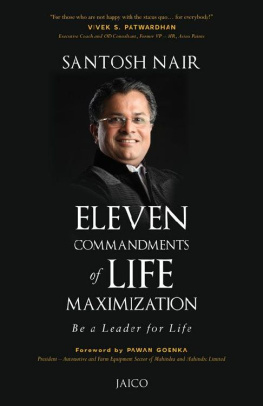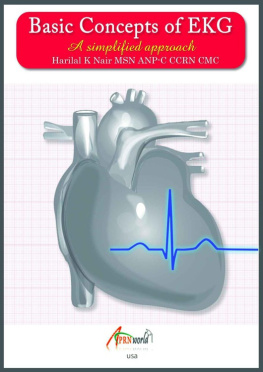Copyright 2020 BookMedia
ISBN: 978-81-949137-5-7
THE WONDERFUL WORLD OF ATOM
Dr. MNR NAIR
All rights reserved. No part of this book may be reproduced or used in any manner without written permission of the copyright owner except for the use of quotations in a book review.
Published by BookMedia
www.bookmedia.co
Contents
ABOUT THE AUTHOR
Dr. M.N.R. Nair. He took his Ph.D. in Physical Chemistry from the Indian Institute of the Science, Bangalore. His Four books on popular science have been published by State Institute of Languages, Trivandrum. In total, he has penned about 15 books, including fiction and non-fiction. Presently he resides at Bangalore. His contact number is 9980192192.
CHAPTER 1
THE TWILIGHT OF THE DAWN
The history of human progress is a never-ending series of contradictions. The fact that progressive modern sciences like Chemistry and Physics have their origins in the crude soil of selfish motives is one such intriguing contradictions. The searches of the Alchemists are being hinted at, here. They were searching for two hypothetical substances, imagined to be possessing magical powers. The first one is called The Philosophers Stone finding a central place in the bestselling novel The Alchemist by Paulo Coelho. It is also known as Chintamani and Parasamani in Indian languages. Interestingly, the word parasa means Persian and the word Alchemist hints at an Arabic origin. Another word indicating Arab origin is Algebra said to have originated from Al Jabar. These linguistic clues indicate a transfer of knowledge and learning from the East to the West. The Philosophers Stone was thought to possess the vital power to convert base metals such as Iron and Lead into Gold. The second one is an omnibus medicine known as Elixir (Also known as Amrut and Mrutha Sanjeevani in Sanskrit), thought of as capable of curing humans from all illnesses as also to make them immortals. (In the bestselling novels of Amish Tripathy, a similar substance is referred to as Somras.) These searches in the twilight of Human History, have never reached their declared goals that is, these mythical substances were never discovered. However, the very same searches sowed the acorns in the fertile soil of human mind, which, in course of time, grew into the giant oaks of Physical Sciences. The continued searches led to the highways leading to the most advanced modern scientific branches such as stem cell research, genetic engineering etc. They also led to the realization of the fission and fusion of atoms and the unlocking of the secrets of stellar nucleosynthesis. We should also keep in mind the fact that they also led to the development of a hitherto unknown source of energy and thereby to the making of the weapons of mass destruction possessing a monstrosity beyond imagination.
CHAPTER 2
THE BEGINNING
The various types of substances found on the Earth how are they made? Man had started asking this question from pre-historic times and had begun to formulate philosophical answers. For instance, according to Hindu Scriptures particularly Maha Bhagavat everything in the Universe is made of five elements, the so called Pancha Bhutas. They are Aakasha (Space), air, fire, water and earth. The Greeks also believed in a similar four elements system (Aakasha excluded). According to some writers, a fifth element called Quintessence (equivalent of Aakasha) was also included. The great philosopher Aristotle was an ardent supporter of the concept of four elements. The concept of the five elements has tremendously influenced the astrological studies of the East as well as the West. (For example, the Zodiac sign of Aries is associated with fire whereas that of Aquarius is linked to water). Notwithstanding the continued faith in Astrology, it is clear to us that this concept has no scientific basis.
The first landmark discovery of the Alchemist was that all substances could be divided into two major categories Elements and Compounds. The elements are pure substances, i.e. they cannot be reduced to anything further or that they do not contain anything else. The compounds, on the other hand, are made up of two or more elements, chemically combined in a constant ratio. Take for example the cases of two common compounds- water and carbon dioxide. Water written as HO using the notations adopted in Chemistry, is formed by the chemical combination of two elements Hydrogen and Oxygen in the ratio of 2:1. Similarly Carbon dioxide CO, the most dreaded greenhouse gas is formed by the chemical combination of Carbon and Oxygen in the constant ratio of 1:2. If the ratio changes, you get a different compound. For instance, if the ratio of Hydrogen and Oxygen is 1:1, you get an entirely different compound Hydrogen peroxide. They also found out that the compounds could be decomposed into their constituent elements employing heat, chemical reagents etc.
Incidentally, there is a third category of substances mixtures- which is the most abundantly found in Nature. However, mixtures, as the name indicates, are formed by the mixing of the two categories mentioned above, elements and compounds, in varying ratios. Air, Earth, Seawater etc. are good examples of mixtures. The separation of mixtures into their components using various physical and chemical methods is of prime importance in the study of Chemistry.
The compounds are made up of elements. Agreed. But how are the elements made? What are their components? The nagging question remained begging for a satisfactory answer through the Centuries.
Before going ahead, the story of the accidental discovery of an element by an Alchemist is worth mentioning. It will throw light on their desperation to find gold at any cost and from any source, rather than any genuine scientific pursuit. The story is about the discovery of Phosphorous by the German Alchemist, Henning Brand in AD 1669.
Henning Brand was trying various methods in the pursuit of Philosophers Stone and Gold, throughout his life. The search was so intense and costly that he lost all his wealth in course of time. In 1669, while making efforts to make gold from urine, he accidentally got elemental phosphorous, which was found to his utter astonishment, to be emitting a greenish light in the darkness. Based on this property, he named it Phosphorous (means emitting light) Chemical symbol P-and thus Phosphorous became the first element whose discoverer is known.
The first person as recorded in History, who tried to give a satisfactory answer to the question, How elements are made? was an Indian Sage called Kanada. Elements are made up of invisible and indivisible micro particles, he said. He called these hypothetical particles Kanas. Kanada also had the reputation of establishing Vysheshika Matha, one of the six sastras of Hinduism. There is no clear-cut indication about the lifetime of Kanada and it is assumed to be around 600 BC. However, one thing is clear. The leading philosophers of established conventional philosophy of the five elements discarded the revolutionary concept of Kanada and rejected it outright. They criticized and ridiculed the sage. The real name of the sage is said to be Pippalada. The name Kanada is said to be a word invented by his opponents to ridicule him. The meaning of the word is one who eats Kanas. The spark of a radically new thinking was, thus, mercilessly suppressed.

